Telescope focal length is confusing.
When looking at a telescope you are presented with things like:
- focal length
- aperture
- focal ratio – and more
Unless you know what you are looking at, it can be hard to make sense of it all. But don’t worry – you are not alone!
Here, I will explain what focal length is, how it affects what you will be able to expect in terms of what you will be able to see through the telescope, and what you should look for in choosing the right telescope for you.
Understanding Telescope Focal Length
Focal length is the distance light travels inside the telescope’s tube (known as the Optical Tube Assembly or OTA).
This is from the entry point (the lens, that captures the light) to the exit point (the focuser, where you place your eyepiece to look through or camera to capture an image).
The distance the light travels is different in different telescope types:
- Refractor telescopes: the light is captured by the lens at one end and focussed to the eyepiece at the end. Therefore the focal length is essentially the length of the tube
- Reflector telescopes and catadioptric telescopes: the light travels down the tube to a primary mirror which reflects it back to a secondary mirror which focuses it to the eyepiece. Therefore the focal length is longer than the OTA length as the light travels further.
Focal length is usually measured in millimeters and will be stated in the description of the telescope on a sales page or the manufacturer’s website:
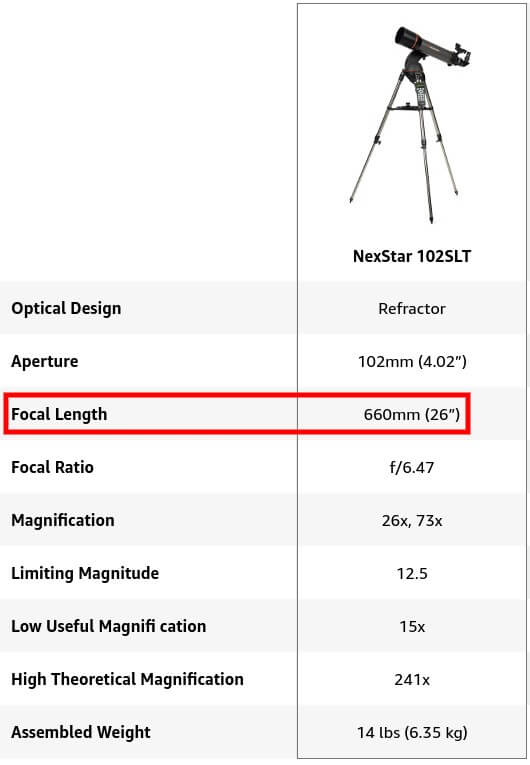
Confusingly, the aperture (a very important specification) is often measured in inches, rather than millimeters.
Aperture is nearly always indicated in the model name. Only sometimes the focal length is as well. For example:
- Celestron Nexstar 4SE: 4-inch aperture
- Celestron NexStar 130SLT: 130mm aperture
- Gskyer 600x90mm AZ: 90mm aperture and 600mm focal length
What does focal length indicate for a telescope?
Focal length determines the magnification and field of view you can get with a telescope. In general:
- Longer focal lengths produce higher magnification and a narrower field of view. This makes them good for observing or imaging smaller or more distant objects like planets or distant galaxies.
- Shorter focal lengths produce lower magnification and a wider field of view. This makes them good for observing larger astronomical objects like nebulae, galaxies, and wide star fields (as long as the aperture is high enough).
But what does “longer” and “shorter” mean? A rough guideline is:
- Short focal lengths are 500mm or less
- Long focal lengths are around 1500mm and above
The ideal focal length and aperture for a telescope will depend on the objects you’re most interested in observing/photographing.
If you are a beginner, just understand that focal length is not the sole indicator of how “powerful” a telescope is. Aperture is the more important measurement of this and how good the views will be, but it is important understand how both work together to influence the performance of a telecsope.
What is a Good Focal Length for a Telescope?
Essentially, there is no such thing as a “good” or “bad” focal length as it depends on what you want the telescope for.
Let’s try and illustrate this now with a few case studies:
Case Study 1: A Cheap Refractor Telescope
Let’s take this Gskyer telescope on sale on Amazon:
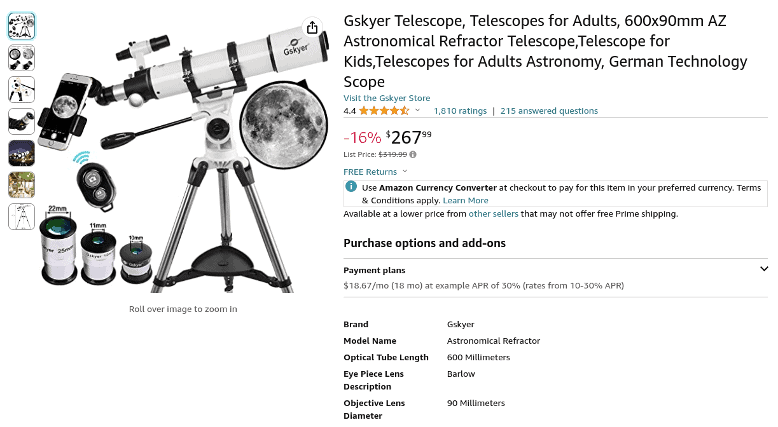
It is a basic refractor telescope with:
- 70mm aperture
- 400mm focal length
This is a fairly low aperture and focal length.
With this, you will not be able to expect too much beyond the moon unless you are in very good conditions – i.e. with dark skies and no clouds, etc.
If conditions are right it will improve your views compared to your naked eyes but not much else.
However, there are pros to a telescope like this:
- It is small and light and so is good for travel. It can be taken on trips where you might be away from the light pollution of your hometown or city and it will provide you with a fun opportunity to explore the night sky.
- It is cheap enough that you might not care too much if it gets damaged and doesn’t survive that long.
- It can be great for families who want something that packs up tidily at home and can be pulled out to play with in the backyard on a nice evening. It is easy to operate and doesn’t require a power source or anything like that.
See the best travel telescopes for more like this model.
Case Study 2: A Mid-Range Catadioptric Telescope
The Celestron Nexstar 4SE is one of the most popular telescope packages on the market. It is a computerized telescope that locates and tracks objects for you:
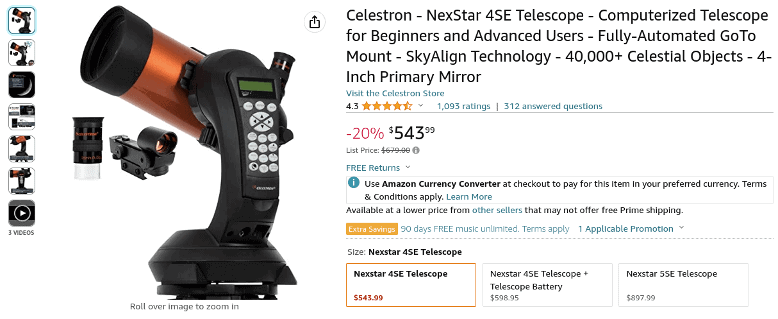
It has:
- 102mm aperture
- 1325mm focal length
Here the aperture is large enough to significantly improve your views and the focal length is fairly long and so will be able to zoom into objects like planets.
These Celestron Schmidt-Cassegrain telescopes (SCTs) are particularly good for planetary photography – read more about this in our guide to the best focal length for astrophotography.
The downsides to a telescope like this are:
- It is more expensive than a basic non-computerized model
- It is less portable and requires a power source like being plugged into the AC or a portable battery
Case Study 3: An Apochromatic Refractor Telescope
Lastly, this Sky-Watcher EvoStar 72 is an apochromatic refractor telescope which is specialized for astrophotography:

It has:
- 72mm aperture
- 420mm focal length
You might notice that this is similar to the Gskyer model above, but the key difference is the optical design which makes it excel for imaging, rather than observing.
How someone would use this telescope is to:
- Have it on a high-quality mount – see the best mounts for astrophotography
- With a high-resolution dedicated astronomy camera – see the best CCD and CMOS cameras for astrophotography
What they would do is take very long exposure images with the mount tracking the night sky as the earth rotates and the object “moves”.
They then have a large, widefield image that could be a of single large astronomical object, or they could crop into smaller objects.
The downsides of a telescope like this are that they are not for beginners:
- They require a lot of knowledge and practice to make work
- They require the other components of an astrophotography setup like mount and camera and all this becomes expensive
They are great for astrophotography though and are also fairly portable and affordable compared to many other astrophotography telescopes. See the best apochromatic refractor telescopes for more on this.
We’ll now dive a little deeper into focal length and how it relates to:
- Magnification
- Field of view
- Focal Ratio

How Focal Length Affects Magnification
One of the effects of focal length on a telescope is that it determines how much magnification you can get when combined with a certain eyepiece.
Magnification is the ratio of the focal length of the telescope to the focal length of the eyepiece. It indicates how much larger an object appears through the telescope compared to the naked eye.
For example, if you observe something at 50x magnification, it means that it appears 50 times larger than if you looked at it with your eyes.
To calculate magnification you simply to divide the focal length of the telescope by the focal length of the eyepiece (both in millimeters).
For example:
- A telescope with a focal length of 1000mm and an eyepiece with a focal length of 20mm has a magnification of 50x (1000 / 20)
- The same telescope with an eyepiece focal length of 10mm has a magnification of 100x (1000 / 10)
However, higher magnification does not always mean better image quality, as it depends on other factors such as aperture, atmospheric conditions, and optical quality.
Higher magnification means that you zoom in on your target, getting closer and narrowing the field of view, but it also means that any atmospheric turbulence that may interfere with your views will also be magnified.
Theoretical Limit of Useful Magnification
There is also a measurement of the limit to how much magnification you can use with any individual telescope – this is the theoretical limit of useful magnification.
This is a simple formula that says the maximum magnification of a telescope is 50 to 60 times its aperture in inches, or two times its aperture in millimeters.
For example:
- A 60mm aperture telescope will have a maximum useful magnification of about 120x.
- A 203mm aperture telescope will have a maximum useful magnification of about 400x.
If you use more magnification than this limit, you will see larger but fainter and more distorted images.
Therefore, when choosing a suitable magnification for your telescope and eyepiece combination, you need to consider both your focal length and your aperture, as well as the viewing conditions and the type and size of the object you want to observe.
In general, lower magnifications are better for observing large and bright objects such as galaxies and nebulae, while higher magnifications are better for observing small and faint objects such as planets and globular clusters.

How Focal Length Affects Field of View
Another effect of focal length on a telescope is that it determines how much field of view you can get.
Field of view is the angular size of the area that is visible through the eyepiece. It indicates how much of the sky you can see at once through the telescope.
For example, if you have a field of view of 1 degree, it means that you can see an area of the sky that is 1 degree wide and 1 degree high, which is about twice the size of the full Moon.
Field of view is inversely proportional to magnification, meaning that higher magnification results in a narrower field of view, and lower magnification results in a wider field of view.
This makes sense because when you zoom in on an object, you see less of its surroundings.
For example, if you observe Jupiter at 100x magnification, you will see more details on its surface, but you will not see its four largest moons. If you reduce the magnification to 50x, you will see fewer details on Jupiter, but you will see its moons as well.
Calculating Field of View
To calculate the field of view of your telescope and eyepiece combination, you need to know the eyepiece apparent field of view (AFOV), which is the angular size of the circle that you see when you look through the eyepiece.
AFOV depends on the design and quality of the eyepiece and is usually measured in degrees.
For example, a typical Plossl eyepiece has an AFOV of about 50 degrees, while a wide-angle eyepiece may have an AFOV of 80 degrees or more.
The formula for calculating the field of view is:
- field of view = eyepiece AFOV / magnification
For example, if you have an eyepiece with an AFOV of 50 degrees and a magnification of 100x, then your field of view is 50 / 100 = 0.5 degrees.
Field of view is important for choosing which objects to observe, as some objects are larger or smaller than others in the sky. For example:
- If you want to observe the Andromeda Galaxy, which has an apparent size of about 3 degrees by 1 degree, you need a low magnification and a wide field of view to fit it in your eyepiece.
- If you want to observe Saturn’s rings, which have an apparent size of about one arcminute (or one-sixtieth of a degree), you need a high magnification and a narrow field of view to see them clearly.
Therefore, when choosing a suitable field of view for your telescope and eyepiece combination, you need to consider both your focal length and your target object.
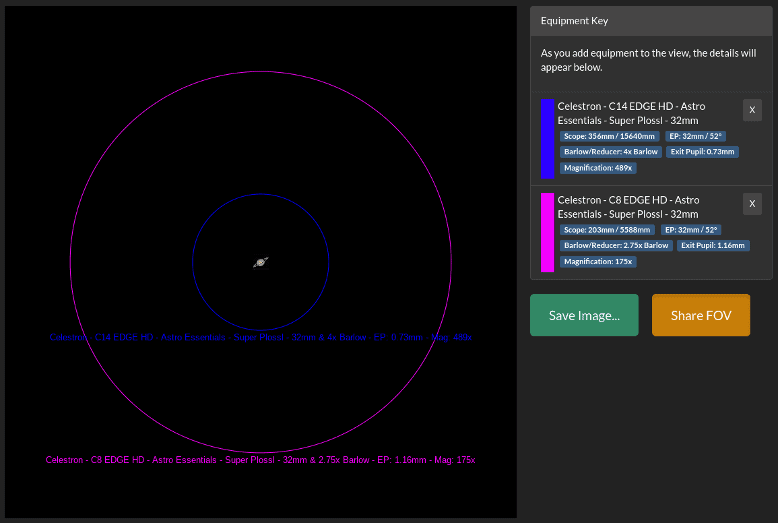
How Focal Length Affects Focal Ratio
Focal ratio is the ratio of the focal length to the aperture. It is usually expressed as a fraction, such as f/5, f/10, f/15, etc. The smaller the fraction, the lower the focal ratio, and vice versa.
You can calculate the focal ratio of your telescope by dividing the focal length by the aperture (both in millimeters). For example:
- Celestron StarSense Explorer DX 130AZ: a focal length of 650mm and an aperture of 130mm. Therefore the focal ratio is 650 / 130 = 5, or f/5.
- Sky-Watcher Classic 250 Dobsonian: a focal length of 1200mm and an aperture of 257mm. Therefore the focal ratio is 1200 / 257 = 4.7, or f/4.7.
Focal ratio is also usually stated in any telescope’s specifications:
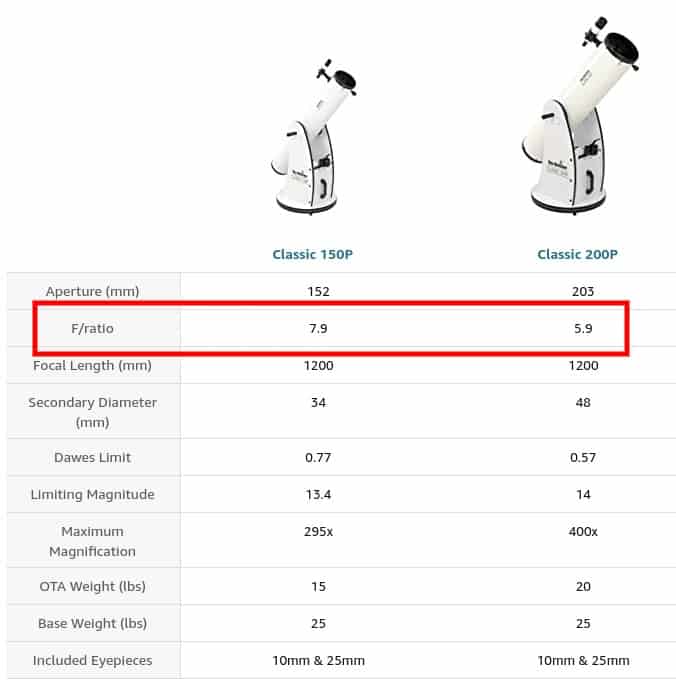
Focal ratio affects the brightness and contrast of the image, as well as the exposure time for astrophotography:
- Lower focal ratios (such as f/5) produce brighter and faster images but may suffer from optical aberrations such as coma or chromatic aberration.
- Higher focal ratios (such as f/15) produce dimmer and slower images, but may have better optical quality and resolution.
Lower focal ratios are better for capturing faint and extended objects such as galaxies and nebulae, because they collect more light in a shorter time and have a wider field of view.
However, they may require more complex optical designs and corrections to avoid distortions and color errors. They may also require larger and heavier mounts to support the telescopes.
Higher focal ratios can be good for observing bright and compact objects such as planets, because they have more contrast and resolution and less chromatic aberration.
However, they may require longer exposure times and narrower fields of view for astrophotography. They may also have more diffraction effects due to the smaller aperture.
Telescope Focal Length FAQs
Is A Longer Focal Length Better For A Telescope?
A longer focal length is not necessarily better for a telescope. Long focal lengths are good for some purposes, and short focal lengths are better for others. It is not a case of higher is better.
This is why is it a bit more complicated than aperture, where higher is pretty much always better in terms of the views it will provide. The only downsides to higher aperture are increased weight and price, as telescopes with higher aperture (and bigger lenses) are heavier and more expensive.
How to find the focal length of a telescope?
There are different ways to find the focal length of a telescope, depending on how much information you have about it. Here are some common methods:
- Check the label, manual or online page: The easiest way to find the focal length of a telescope is to check the manufacturer’s information. Most telescopes have their focal length printed on them, usually near the front or back end of the tube. For example, you may see something like “1000 mm f/10” or “FL 1000 mm”. If you don’t have the label or manual, you can also try searching online for your telescope model and specifications.
- Use a formula: Another way to find the focal length of a telescope is to use a formula that relates it to other parameters, such as aperture and focal ratio. For example, if you have a telescope with an aperture of 200 mm and a focal ratio of f/5, then you can calculate its focal length by multiplying them: 200 x 5 = 1000 mm.
Verdict: Focal Length and Telescopes
Understanding focal length is important when choosing a telescope to buy and it is not as simple as ‘higher is better’.
In addition, if you already have a telescope knowing its focal length is important for a couple of reasons:
- It helps you get the best performance from your telescope: Knowing your telescope’s focal length can help you plan what objects to observe and how to observe them. Different objects require different magnifications and fields of view to appreciate them fully.
- It helps you choose compatible eyepieces: Eyepieces have different focal lengths that affect how much magnification and field of view they provide when used with a telescope. To get the best performance out of your eyepieces, you need to match them with your telescope’s focal length.
I hope you found this guide useful. If you want more on this topic, check out this video:
Let me know if you have any questions by leaving a comment or getting via email or social media.



